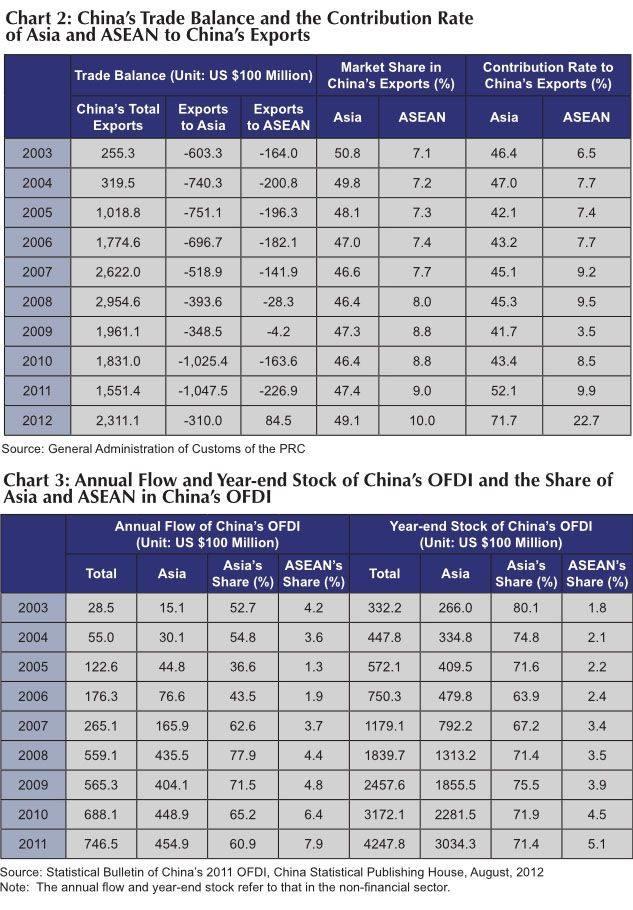China and Asia Grow Together
By HU JIANGYUN
THE world has witnessed rapid eco- nomic development in China and other Asian countries, especially since the 1997 financial crisis. It is now clear that, regardless of the present or the future, China and its Asian counterparts will grow together.
As regards foreign trade, China is both the largest export market for other Asian countries and the most important import market for Asia as a whole. From 2002 to 2011, exports to China from Asias developing economies (countries other than Japan and Israel) rose from US$146.76 billion – a 9.4 percent market share –to US $762.12 billion – a 12.5 percent market share, according to UNCTAD (United Nations Conference on Trade and Development) statistics. ASEAN (Association of Southeast Asian Nations) exports to China also grew from US$21.87 billion – a 5.4 percent market share –to US $142.76 billion – an 11.5 percent market share. The contribution rate here refers to the ratio between the growth in volume of exports to China and of the total export volume.
Chinas contribution to the exports of Asian developing economies has since changed from 20.3 percent to 12.6 percent, and its contribution to ASEAN exports from 26.6 percent to 15 percent (see Chart 1). This implies that Chinas rapid economic development has elevated Asian countries exports to China and thus promoted their economic growth.
From 2003 to 2012, China enjoyed a surplus in world trade, but the reverse was true of that with Asian countries, evident in a trade deficit in 2011 of US $104.75 billion. Other than in 2012, there was also a trade defi cit with ASEAN countries. As to Chinas exports, those to the Asian market fell from 50.8 percent to 49.1 percent, of which exports to ASEAN rose from 7.1 percent to 10 percent. Of Chinas total exports, Asias contribution rate rose from 46.4 percent to 71.7 percent, and that of ASEAN from 6.5 percent to 22.7 percent (see Chart 2). Asia, therefore, has been vital to Chinas development, the relationship between China and Asia having been one of mutual benefit and inclusive growth.
The annual fl ow of Chinas OFDI (Outward Foreign Direct Investment) to Asia rose from 52.7 percent in 2003 to 60.9 percent in 2011, of which that to ASEAN rose from 4.2 percent to 7.9 percent. Asias share in the year-end stock of Chinas OFDI fell from 80.1 percent to 71.4 percent, thus sustaining a rate above 60 percent, of which ASEANs share rose from 1.8 percent to 5.1 percent (see Chart 3). Asia is now Chinas key investment market, where it generates job opportunities, increases local tax revenues and contributes to improvements in peoples welfare and living standards.
China and other Asian countries have accelerated regional integration since the turn of the 21st century. In 2002, China signed a comprehensive cooperation framework agreement, including trade in goods and services and investment protection, on setting up the China-ASEAN Free Trade Zone in 2010. In recent years the United States has pressed for the Trans-Pacifi c Strategic Partnership Agreement (TPP), and ASEAN for the Regional Comprehensive Economic Partnership (RCEP). The original ASEAN + X mode and acceleration of regional integration has gradually made Asia an important engine of global economic growth.
From the perspective of the international fi -nancial system, China has always safeguarded the socio-economic stability and common development of Asia. In line with its responsibilities as a big country in Asia, the Chinese government has stuck to the policy of stabilizing the RMB exchange rate to allay risks pertaining both to the Asian financial crisis of 1997 and the world economic downturn of 2009.
But there are still obstacles to the common growth of China and its Asian counterparts. In addition to trade protectionism, concerns about the ecosystem and a weak infrastructure foundation inhibit development. There are also sizable gaps among various economies due to different social systems. In carrying out its development strategies, however, China will nonetheless stick to the principles of mutual benefit and win-win outcome and take the road of peaceful development to realize common progress in all Asian countries, and safeguard regional stability and economic development.

